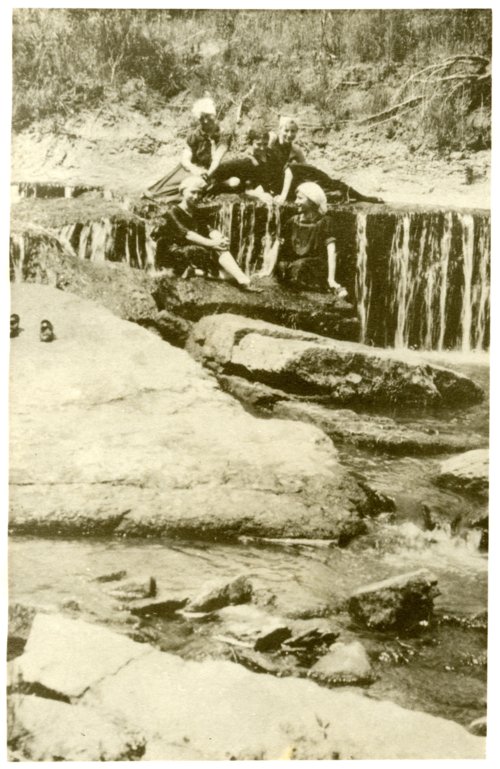Written by Holly Hill
MA Student – Department of History
HGSO Vice President
Help Desk Student Specialist – Hale Library
To get into the spirit of Valentine’s Day, I turned to my favorite genre of fiction: historical romance. I know I’m not the only one: romance is the most popular genre of fiction, and historical romance is its most popular subgenre!1 I specifically went looking for historical romances set in Kansas – and found The Manhattan Stories, written by Donna Mabry. I read the first two books in the series: Jessica and Pillsbury Crossing.
As a history major, I am accustomed to ignoring the glaring flaws of historical romance – I’m not reading Bridgerton for an accurate depiction of the Regency Era. Yet, surprisingly and delightfully, Mabry’s Manhattan Series is clearly grounded in the history of Manhattan, Kansas. However, once reading more about Mabry, it is less surprising: one of her main sources was Manhattan’s own Lowell Jack, an expert on all things related to the Little Apple. She also lived in Manhattan on Vattier Street while her husband was stationed here.
The first book, Jessica, begins in the Big Apple. Its titular heroine is the daughter of wealthy New York financier, and with Black Friday on September 24, 1869, both her father and her new husband lose their money. Her husband, the never-redeemed scoundrel Zachary Belk, drags the pregnant Jessica to the other Manhattan, and here her trials truly start.
Her husband abandons her after her daughter’s birth, so Jessica must provide not only for herself and her baby, but her two servants and father-in-law. A talented seamstress, she begins to sell textiles to Wareham Mercantile. For women on the prairie, domestic manufacture was a common way to support themselves.2
Because of this wayward husband situation, the love story is a bit of a slow burn. Her love interest is the local Baptist preacher Daniel Fields: young, handsome, and widowed with a young daughter. Jessica joins his church and teaches piano lessons out of it, so this is where the two begin falling in love. Of course, with Jessica’s husband still out there somewhere, shenanigans ensue and the local townspeople have a lot of gossip fodder!
The second book, Pillsbury Crossing, spans 1884 to 1894. It follows one of the sweetest tropes that the romance genre has to offer: childhood friends to lovers. Isaac Belk – who prefers the name “Akecheta,” given to him by his Kaw adoptive mother Mimi – saves his neighbor girl Emma from drowning in Deep Creek and declares her “his.” Some of their childhood adventures include fighting a bear, which I did not realize Kansas ever had before I read this book and had to look it up with the Kansas Department of Wildlife and Parks.
As Akecheta and Emma grow up together, they face diverging paths: he goes off to New York to study law, and she stays behind to go to Kansas State Agricultural College. Though the big city (and a beautiful socialite) almost sway him, after a mountain of angst, he finally realizes that his heart is in Kansas.
Now, a hallmark of romance is swoon-worthy lines. I haven’t been the same since my first viewing of Pride & Prejudice (2005). In Pillsbury Crossing, Akecheta proves himself to be a man after my own grad student heart when he doesn’t let Emma drop out of school for him: “I love you too much to be the one who took your education away from you” (352). Pretty smooth.
Overall, I really appreciated the women’s issues that the books touch on. It shows how women dealt with things like divorce, finances, and education. Heroines Jessica and Emma are strong, resilient, and intelligent – and they fit right in with the trailblazing women that Kansas history is full of.
These little pieces of history are what make historical romance so wonderful. We all learn about the world through popular culture, so it’s always great when books can give you some real facts to go along with the fun. Plus, historical romance comes with a guaranteed happy ending, unlike real history, and I think that’s what makes these books perfect for Valentine’s Day reading!

Photo courtesy of the Kansas Historical Society. (https://www.kansasmemory.org/item/307075)

Photo courtesy of the Kansas Historical Society. (https://www.kansasmemory.org/item/307077)
- Lisa J. Hackett and Jo Coughlin, “The History Bubble: Negotiating Authenticity in Historical Romance Novels,” M/C Journal 24, no. 1 (2021), https://doi.org/10.5204/mcj.2752. ↩︎
- Sandra L. Myres, Westering Women and the Frontier Experience 1800—1915 (University of New Mexico Press, 1982), 240. Historical Romance Novels,” M/C Journal 24, no. 1 (2021), https://doi.org/10.5204/mcj.2752. ↩︎


